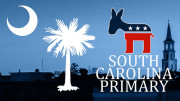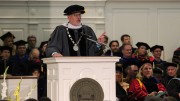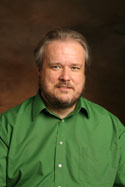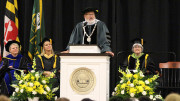https://www.youtube.com/watch?v=yHAywlBxFFQ
Screams are heard as the smoke writhes and twists, paralleling the insanity of violence, passion, and tired but focused opposition. The sound of gunfire and flash grenades fill the air, as young men and women sit, their eyes glazed over from exhaustion and exasperation. Their minds are tired from combating the line of police constantly at the ready, and always prepared to use violence to silence. Tear gas disperses protestors, and comrades willing to sacrifice their lives for one another drag bodies off the streets.
These are just some of the scenes captured the past few days, by amateur cameramen, at Kiev’s city center, scenes of violent opposition to further government control. The past few months have been a breeding ground of inner turmoil in the Ukraine, with anti-government/pro-EU protestors taking to the streets in defense of their rights.
The situation has been blowing up the Internet; social media from Twitter to Tumblr has been championing the cries of hundreds of thousands of Ukrainians as they gather in Kiev’s Maidan Nezalezhnosti (Independence Square) in an attempt to stop an already powerful government from gaining any further hold over the people, with major news broadcasts lagging in their initial coverage of events. The questions we should be asking are: what started this entire conflict; what are the major issues at play; who are the players?
The Protests
In November of 2013, peaceful protests began in the middle of Kiev after former President Viktor Yanukovych (former in that he was removed from office February 21st) decided to make a complete U-turn with regards to a trade agreement with the European Union that had been years in the making, favoring closer relations with Russia.
The protests began strong, with the portion of the Ukrainian population in favor of joining the E.U. marching on the Maidan. Flag-waving protestors chanted in unison “Ukraine is Europe” in an attempt to influence Yanukovych to follow through with the E.U. trade agreements. The protests happened nationally on a large scale, not merely in the capital city. These early protests were ineffective in that they did little to change the minds of those in power.
A second wind hit the protests however when there was a harsh dispersal by police of protesters from Independence Square on Nov. 30. The police chief was sacked but the damage had been done, and the protesters shifted their energy from only pro-E.U. demands to clear demands of toppling the current government.
The protests took a turn in Kiev when violent protesters began to fight police cordons and as barricades were erected. For some time peaceful protesters tried to separate themselves from the violence, though both groups coexisted with little tension. However after Kiev officials passed Draconian laws intent on subjugating any form of anti-government public protest, there grew a silent acceptance of the Maidan “battlefront.”
Jan. 16 saw the implementation of Draconian style laws intended to squash government opposition protesters. Some of these laws included or prohibited:
1) Government can decide to prohibit Internet access.
2) Riot police and officials who committed crimes against protesters are exempt from punishment.
3) Disrespect of the courts. (15 day arrest)
4) Distribution of extremist material. (3 years imprisonment)
5) Mass disruptions. (10-15 years imprisonment)
6) Participating in peaceful protests while wearing a helmet or uniform clothing. (10 day arrest)
7) Setting up tents, stages and even sound equipment without police permission. (15 day arrest)
8) You can be convicted by the courts in “absentia.”
9) Illegal to drive a car in a column larger than five cars. (2 years imprisonment)
10) Threatening a police officer. (7 years imprisonment)
The Players: Ukraine’s deep cultural/political divide.
The footage on the Internet shows masses of people hurling stones at police formations, but it’s not as simple as “the people against the government.” What the Ukrainian population faces is a demographic as well as ideological rift, with half of the country wishing closer ties be formed with the European Union, and the other half hoping that Ukrainian connections with Russia will be strengthened. This ideological rift comes from the cultural fissure that exists within the Ukraine. Those who live on the Eastern side of the country (closer to Russia) are often Ethnic Russians who predominantly speak Russian, whereas those from the Western region are Ethnic Ukrainians.
The Washington Post’s Max Fisher states this reality clearly, “Roughly speaking, about four in every six people in Ukraine are ethnic Ukraine and speak the Ukrainian language. Another one in six is ethnic Russian and speaks Russian. The last one-in-six is ethnic Ukrainian but speaks Russian.”
Needless to say this deep demographic divide is something that needs to be addressed; but why does this demographic divide matter? Here’s why: since 1991 when the Ukraine declared independence, the country has been politically divided, with those who are Ethnic-Ukraine’s voting for one candidate and those who are Ethnic-Russian or Russian speaking vote for the other. As Fisher posits, it’s much like the American “blue and red” divide, but far stronger; imagine that both parties speak completely different languages and have completely distinct cultural realities.
The fight between two ideological principles—further economic connection to the West versus closer allegiance with Russia economically—is clearly defined by the demographic divide in the country.
This demographic divide is not, however, the cause of these protests and of the grievances being voiced by those participating in what is being called the Euromaidan. It does give important insight into a political reality within the country that remains unresolved, and while the demographic divide is not the cause of the people’s grievances, Yanukovych’s rejection of the E.U. trade agreement and the growing control of a power hungry government are.
What’s happening now?
As of Friday Feb. 21, the opposition has signed a deal with Yanukovych, which states that elections will be held by the end of this year when previously they had been planned for March of 2015, as well as a promise to revert to the 2004 constitution which trims Presidential powers, and the release of political jailed opposition leader Yulia Tymoshenko.
The agreement, published by the German foreign ministry, includes the following:
1) Within 48 hours of the signing of this agreement, a special law will be adopted, signed and promulgated, which will restore the Constitution of 2004 including amendments passed until now. Signatories declare their intention to create a coalition and form a national unity government within 10 days thereafter.
2) Constitutional reform, balancing the powers of the President, the government and parliament, will start immediately and be completed in September 2014.
3) Presidential elections will be held as soon as the new Constitution is adopted but no later than December 2014. New electoral laws will be passed and a new Central Election Commission will be formed on the basis of proportionality and in accordance with the OSCE & Venice commission rules.
4) Investigation into recent acts of violence will be conducted under joint monitoring from the authorities, the opposition and the Council of Europe.
5) The authorities will not impose a state of emergency. The authorities and the opposition will refrain from the use of violence. The Parliament will adopt the 3rd amnesty, covering the same range of illegal actions as the Feb. 17 2014 law.
This along with a striking political move by parliament to oust Yanokuvych, are phenomenal results of the protestors movement, though the country still has a long way to go. Violence still erupts occasionally on the streets between protestors and the police force, and while the agreement reached between President and opposition leaders has been looked on with favor by outside forces, the protestors themselves are not convinced, some even berating the three opposition leaders who signed said treaty, labeling them traitors.
As the situation in the Ukraine develops the world is watching as to whether or not the agreement will be enforced, and backed by both the government and the opposition. Until that time however, the Ukrainian people stay at their posts, fighting for their freedoms and a better Ukraine.
Here are four live feeds of the goings on in Kiev’s city center (all in Ukrainian, mind you).
http://feed.matthewkeys.net/cr1/
Sources:
http://rt.com/news/ukraine-maidan-protest-developments-982/




